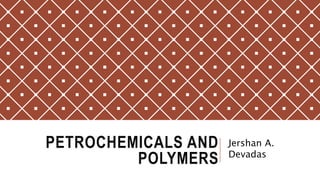
Petrochemicals and Polymers: Formation and Properties
- 2. FOSSIL FUELS Formed in the earth’s crust from material that was once living COAL - fossil plant material PETROLEUM/ CRUDE OIL - bodies of marine organisms NATURAL GAS - bodies of marine organisms It takes millions of years for the formation of these fossil fuels Non-renewable Finite resource.
- 3. PETROLEUM - FORMATION1) Marine creatures died, sank to the seabed and were covered by mud. 2) High pressure, high temperature and bacteria acting changes them to petroleum and natural gas. 3) Organic material broke down into hydrocarbons. 4) Compression of mud transformed the hydrocarbon into shale. 5) Geological movements and pressure changed this shale into harder rocks, squeezing out oil and gas. 6) Oil and gas moves upwards through the porous rocks and becomes trapped by a layer of non-porous rocks. 7) Reservoirs of oil and gas are created – they spread throughout
- 4. FRACTIONAL DISTILLATIONPetroleum – mixture of different hydrocarbon molecules Hydrocarbon molecules are separated by refining. This is done by fractional distillation in a oil refinery. 90% petroleum is used as a fuel; 10% petroleum is used as a feedstock. Petroleum is separated into different fractions – groups of hydrocarbons that have different boiling points. Separation takes place by fractional distillation in a
- 5. 1) Petroleum is preheated to a temperature of 350 – 400oC and pumped at the base. 2) As it boils the vapour passes up the tower through a series of bubble caps and cools as it rises. 3) Different fractions cools and condenses at different temperatures, and therefore, they are collected at different heights in the tower. 4) They are collected on trays. 5) Individual single hydrocarbons can be obtained by further distillation.
- 7. CATALYTIC CRACKING For lighter fractions, such as gasoline, demand is high. For heavier fractions, such as kerosene, the demand is low. Larger molecules can be broken into smaller, more valuable molecules through a process called Catalytic Cracking. 1) Particles of catalyst are mixed with the hydrocarbon fraction at a temperature around 500oC. 2) Cracked vapours are separated by distillation. 3) Shortened hydrocarbon molecules are produced by the following reaction: decane octane + ethane C10H22 C8H18 + C2H4 Heat Catalyst
- 8. All cracking reactions give: An alkane with a shorter chain Short-chain alkene Two or more alkenes and hydrogen. Shortened alkanes can be blended with the gasoline fraction to enrich the petrol. The alkenes are useful as raw materials. Propene polymerises to poly(propene). Butene polymerises to produce synthetic rubber.
- 9. BLENDING GASOLINE Some of the products from cracking are added to the gasoline fraction to improve the quality of petrol. High-quality petrol contains many branched-chain hydrocarbons, made by re-forming, so that the fuel does not ignite too soon. Unleaded Petrol is used in modern cars fitted with catalytic converter. Levels of sulfur dioxide, carbon monoxide, unburnt hydrocarbons and oxides of nitrogen are reduced using catalytic converter.
- 10. ALTERNATIVE FUELS AND ENERGY SOURCES FUELS Diesel Gasoline from methanol LPG and CNG Biofuels Others (ethanol and hydrogen - powered vehicles, electric, solar, etc.) ENERGY SOURCES Biogas Anaerobic bacteria decompose organic matter under geologic conditions to produce natural gas (methane) Methane is useful for heating, cooking and the solid is used as a
- 11. ADDITION POLYMERISATI ON Synthetic polymers are called plastics. They have properties to suit particular needs. Large organic macromolecules made up of small repeating units known as monomers joined together by polymerisation. Homopolymers – contains one monomer; Eg: poly(ethane), poly(propene), poly(chloroethene). Copolymers – made of two or more different types of monomers; Eg: Nylon, biological proteins. Double bond is broken and other atoms attach to the carbon atom.
- 13. PROPERTIES OF ADDITION POLYMERS All polymers are long-chain molecules made by joining together a large number of monomer molecules. Addition polymerisation involves monomer molecules that contain a C C double bond. Addition polymers are homopolymers, made from a single monomer. During addition, the double bonds open up and the molecules join to themselves to make a molecule with a long chain.
- 15. CONDENSATION POLYMERISATION Nylon Polyesters Biological polymers Proteins Carbohydrates Food
- 16. NYLON It is a solid, but it can be melted and forced through small holes. Moulded into strong plastic items. Copolymer of diamine and dicarboxylic acid. Amine group on the first monomer reacts with a carboxylic acid group on the second monomer to form a link; a water
- 17. POLYESTERS One monomer has an alcohol group and the other monomer has a carboxylic acid group. When the react, an ester link is formed, with water being lost each time. Terylene (a polyester) – turned into fibres and woven into clothing; its softer. Terylene can be broken
- 18. BIOLOGICAL POLYMERS PROTEINS: Built from amino acid monomers. Contain two functional groups – NH2 and – COOH. They react together to form amide linkage which produces dipeptide. Upto 15 amino acids – peptides 15-100 amino acids – CARBOHYDRATES: Compound containing carbon, hydrogen and oxygen. Ratio of hydrogen to oxygen is 2:1. All long-chain carbohydrates (polysaccharides) are long- chain condensation polymers
- 19. FOOD Main constituents are proteins, carbohydrates and fats. Digested and converted back to their monomers, which are used as building blocks or sources of energy. FATS – mixture if large molecules that are the esters of long-chain carboxylic acid molecules and glycerol. Fats that contain unsaturated acids are called unsaturated or polyunsaturated fats. Fats that contain saturated acids are called saturated
